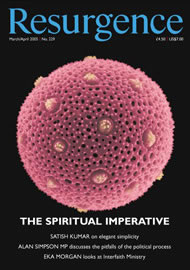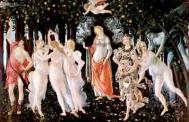IN THAT HEADY, imaginative and vital period of Italian culture in the fifteenth century, the Quattrocento, a person could look at the sparkle in a stone and see the captured radiance of the stars, or visit a highly developed garden and find several cultivated sections dedicated to the planets. "As above, so below," they said, summarising the ancient Emerald Tablet. The idea was to connect the highly spiritual realm of the stars with the earthy ground of daily life - spirituality and soul.
We need a richer, more grounded, more poetic understanding of ecology, which is not only the preservation of the planet but the enrichment of the human life on it. Renaissance gardeners offer hints on how we might go about an interplanetary style of ecology.
First, they said that the soul has many different daily needs. To describe these needs they used traditional imagery of the planets, each representing a bundle of emotions or aspects of daily life. You may need a garden for the sheer beauty of plants, trees, and flowers - Venus. You may be looking for a place to have a conversation with a friend - Mercury. You may need a small body of water or a fountain for fluidity and reflection - the Moon. A garden could be a good place for a party - Jupiter. It may help cool off rage - Mars. It could offer sunny spots for a sense of wellbeing - the Sun. There may be a shaded, remote spot for solitude - Saturn.
Too often, perhaps, we think of ecology in purely scientific terms, or we might be caught up in only one aspect of nature. Some people seem to love the Diana spirit of wilderness and shy away from the more cultivated beauty of cut flowers and formal gardens. Some honour the Demeter aspect of grains, food and farming and have little regard for grafted fruit trees, topiary and terracing.
Not far from my home in New Hampshire is a wondrous place called Rosaly's Garden. There people can buy home-grown organic food, cut flowers from the many and varied plots, or find many familiar and exotic herbs. They can pick berries and walk among the rows of bushes and trees and arbours. They can see the mountains on the horizon and, as some do, set up their easels for an afternoon of watercolours and oils. They may go there to get food, take a walk, solve a marital problem, or get away from the pressures of life. A garden is a place where you work on the soul as well as the soil.
A garden is a cultivated patch of earth designed for many different needs of the body, the soul and the spirit. In a sense, the planet itself is a garden, and it is no accident that many mythologies say that human life began in a garden. Deep down and in our origins we are garden people.
The mythology of the modern era tends to look at land and see productivity, yield and profit. Or it pictures a huge laboratory for research and study. Surely, there is a god of analysis and one of the market, but there are many others that should not be neglected. Ecology is as close to art as it is to science, as much a spiritual practice as a study of nature. It is as much about creating a suitable cultural habitat as it is about saving the wilderness. It takes place in the city as well as in the countryside.
A cultivated garden is to wild nature as manners and civility are to daily survival. We live in a pragmatic age, where plain facts occupy both those who exploit the Earth for its resources and those who envision a more congenial relation to nature. Yet the cultivation of beauty and grace humanises us, the Renaissance Platonists said, and prepares us for a more thoughtful engagement with our world. Ecologists might realise that care of the Earth requires a caring heart, which is cultivated by beauty, form and manners, in a garden as well as in a forest.
In one of his letters, Marsilio Ficino, the ringleader of the magical philosophers and artists of fifteenth-century Florence, said that you can rid your life of its misery and gloom with a clear, smooth wine. He is said to have been a moderate Epicurean, a vegetarian priest and astrologer, who kept a full wine cellar. But fearing that he might scandalise someone, he quickly added, "Oops. Maybe I've gone too far. I also honour Ceres, the spirit of the garden, and her apples and cabbages."
Many paintings of the Annunciation portray Mary reading in a garden when the angel appears to tell her she is pregnant with divinity. This is a great mystery that takes place in the hortus conclusus, the enclosed, formal, cloister-like garden. Out in nature we discover the necessary pagan spirits of water, land, air, and vegetation. But in the enclosed garden we hear the voice of the angel announcing our destiny. It is a priceless message given in a most valuable plot of cultivated land.
Finally, let me remind you of the extraordinary painting of Botticelli known as la Primavera, springtime. It is a huge painting showing the garden of Venus, complete with the spirits usually honoured by ecologists - the stirring winds, the green grasses, and the colourful blossoms. But the painting also has room for three deities - Venus, Eros, and Mercury - and three graces - sometimes identified as beauty, pleasure, and restraint. This painting, from the community of Florentine Platonists, could be an ecologist's bible. It offers a visual definition of ecology, a gathering of the multicoloured spirits of graciousness and beauty. We could cultivate this garden of beauty and grace around our homes, on the planet, and within ourselves. That would be ecology with a soul.
Thomas Moore was a Catholic monk. He is author of Care of the Soul and Original Self.








